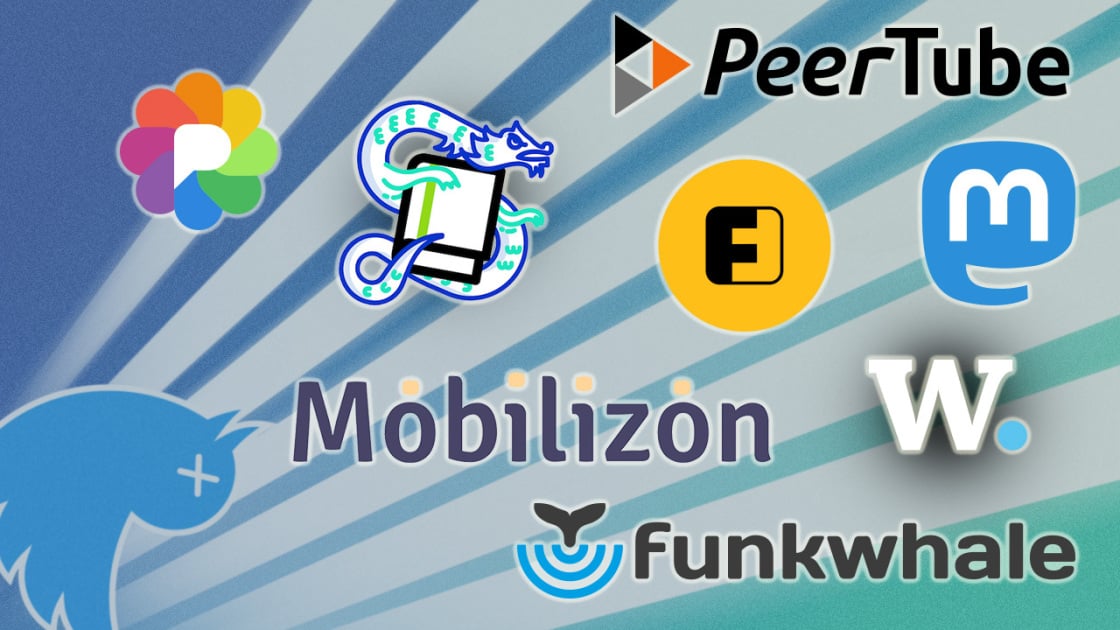
Tired of Twitter? Exasperated with X? Fatigued by Facebook? Injured by Instagram? Ticked off at TikTok? There’s a whole world of alternative social spaces that use intriguing new technologies and break the traditional, centralized paradigm. And they are growing fast.What Are Alternative Social Networks?Here’s what they aren’t: Facebook, Twitter X, Instagram, TikTok, Snapchat, or anything like that. You already know about those digital places, and there are plenty of reasons to avoid them. Our short list of lesser-known social sites either mirror services you’re already familiar with or go in an entirely new direction. Many (but not all) are community-operated, decentralized, free, open-source, privacy-focused, and ad-free.All the services in this list are built on the ActivityPub protocol, which allows decentralized social networks using independent servers. They each have their own community and rules. Imagine that, instead of there being just one Twitter, there were dozens of individual websites all running Twitter’s code and communicating with one another. That’s a decentralized network.Some ActivityPub services can also interact with each other, forming a larger network of social platforms called the fediverse. Some fediverse services can talk with each other, even though one may be for microblogging and the other for photo sharing. By contrast, you can’t follow a Twitter account from Facebook; those are two entirely separate worlds. This kind of interaction doesn’t always work perfectly, but it’s one of the most exciting facets of the fediverse.
Alternative Social Networks to Replace Twitter, Facebook, and More
Why Should You Quit Facebook, Twitter, and the Rest?The big social media platforms were fun for a while, and they brought people together in a way the old internet couldn’t. Creating an account on Twitter or Facebook is infinitely easier than learning how to host your own website, after all. These platforms gave some people their first opportunity to have a voice online.But X/Twitter, Facebook, and their ilk exacted hidden costs. Social media companies monetize their customers by scraping personal data to better target them with advertising. To keep engagement high, social media companies use algorithmic feeds that keep people scrolling—but can also make them miserable. These companies also frequently ignore bad behavior, including hate speech, apparently accepting human misery as a cost of doing business. They’ve also been bad stewards of our personal information.In fairness, it may not be possible, or even wise, to quit Twitter or Facebook. I maintain a Twitter account, despite the X rebranding, to promote my work and the causes I care about, and my family increasingly turns to Facebook to keep in touch. But I’ve greatly reduced the time I spend on those platforms and have been happier with the low-key experience of Mastodon, Pixelfed, and others.What About Bluesky and Threads?Several new social platforms launched relatively recently from more traditional sources. Threads is a Twitter-like microblogging platform from Facebook Meta, built on the bones of Instagram. Bluesky is a Twitter-like microblogging platform from Twitter founder Jack Dorsey. Although these services are keen to take a bite out of Twitter’s lunch, they both are built on decentralized systems. Fediverse sharing is now available for Threads users, and Bluesky is no longer invite-only.
Recommended by Our Editors
More importantly, although they are alternatives to Twitter, Bluesky and Threads come from established players and have (or likely will have) much of the same ad-based, data-harvesting, poor-moderation troubles Twitter already suffers from. Threads, for instance, requires that you have an Instagram account to sign up, directly linking your Threads account to Meta. In that sense, it’s not really aren’t an alternative to Twitter; it’s an Instagram add-on. These platforms are certainly worth keeping an eye on, but for now, they don’t belong here.Try Something New!A big complaint about offbeat social networks is that nobody uses them. But that’s a self-fulfilling prophecy. After all, Twitter and Facebook weren’t always the darlings they are now. Celebrities and politicians made these services powerful, but they’re only successful because we give them our attention. We can choose to turn that attention elsewhere. Start with the following options:
Best for GoodReads Users
Book clubs aside, reading isn’t always the most social experience. BookWyrm brings book lovers together. Search for books to create a reading list, share your progress and reviews, and see what other readers are reading or adding to their wishlists. But what’s the big advantage over GoodReads? Amazon owns the latter, while the free, open-source BookWyrm project uses the ActivityPub protocol.
Best for Facebook Users
If you’re looking for a more Facebook-y experience, Friendica is worth a look. Friendica is built around profile pages and posts, letting you show off your digital life to your friends. Although it is mostly comparable with Facebook, Friendica draws from other sources as well. You can create private groups similar to the Circles in the now-defunct Google+. You can also use Friendica for planning events, and its multiple profile feature means you can show a different face to your friends, coworkers, and family.
Best for Sharing and Discovering Music
Before Spotify-style streaming subscriptions took off, music lockers were the main way to get your tunes in the cloud. You uploaded all your songs and then streamed them wherever you were. Such services are vanishingly rare these days, but they live on in Funkwhale. With Funkwhale, you upload your music and can share tracks with other users on your server (called a “pod”) as well as with the larger network. When it comes to copyright, Funkwhale is clear that it’s focused on promoting and sharing free content. However, it’s up to individuals to decide what music they share on the system. If you’re looking for a good way to buy music and support artists, take a look at alternatives like Bandcamp.
Best for Twitter Users
Mastodon is a free and open-source microblogging social network in the vein of Twitter before it became X. It’s made up of servers run by volunteer admins, so you can find a home with the rules or focus that you want. Up and running for around eight years, it’s home to a thriving culture with serious, thought-provoking posts and bizarre Twitter-style nonsense. Familiar tools such as faves and reposting (called boosting) are present, but Mastodon does more. The service features visibility settings, giving you some control over who can see your posts. Individual users can also mute and block individual users or entire servers.
Mastodon Review
Best for Organizing Events
While often overlooked, Facebook Events is one of the social networks’ greatest achievements. It’s been a critical part of everything from weddings to protest movements. Mobilizon aims to do the same, but without the surveillance inherent in Facebook’s operations. With Mobilizon, you can create events, share those events as widely as you wish, and keep attendees up to date on developments—all without Facebook’s involvement. (You can still share events on Facebook if you’re into that sort of thing.) Mobilizon is free and open-source, and it federates with other services via ActivityPub. Mobilizon is from the French non-profit Framasoft, which has created a host of open-source, privacy-respecting tools. Of particular note is its Doodle alternative, Framadate.
Best for Sharing Video
Another Framasoft joint, PeerTube takes aim at video-sharing platforms like Google’s YouTube. As with other video platforms, you can upload and watch videos shared on PeerTube. Unlike other platforms, PeerTube is built on independent instances of the same software that communicate via ActivityPub. PeerTube focuses on providing a large amount of content without a large infrastructure. In other words, you can view videos uploaded to one instance across the network. PeerTube also uses viewers to lighten the load on the overall network by having viewers watching the same video exchange some video data. You can watch a great video explainer about PeerTube on—where else?—PeerTube.
Best for Instagram Users
Meta, which we used to just call Facebook, bought Instagram for $1 billion in 2012, which seems rather quaint compared with recent social media acquisitions. Instagram has since become the go-to option for posting pictures of pets and brunch, and it’s also known for its eerily accurate targeted advertising. If you’re sick of the ads, the influencing, and the algorithmic feeds, try Pixelfed. Pixelfed is just like Instagram. You upload photos or videos, crop and filter them, and share them with the world. Pixelfed is free, ad-free, and growing fast. It has already undergone major improvements and is a slick competitor. It also uses ActivityPub, meaning you can follow Pixelfed accounts from Mastodon and other platforms. Apps for Android and iOS are still in testing, but Pixelfed works very well as a web app on mobile devices.
Best for Blogging
Blogger, Medium, and WordPress have all made running a blog extremely simple. WriteFreely is similar and provides a clean, stylish platform for sharing your thoughts with the world. It’s free and open-source, while the ActivityPub protocol under the hood means users on other platforms can see your posts. You can post anonymously to a WriteFreely site or create an account to manage one or several blogs. Posts are formatted with Markdown, so you can quickly create a post without fussing with a bunch of options. Unlike many of the services in this article, WriteFreely has a managed hosting option with paid subscription plans called Write.As. Paid accounts grant access to additional tools, like photo hosting.
( Credit: Vicky Leta )
Cutting back on social media is easier than you might think. Reclaim precious time in your life by following these 9 tips.






